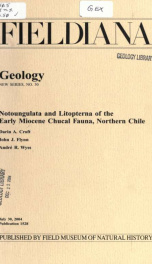Notoungulata and Litopterna of the Early Miocene Chucal fauna, northern Chile Fieldiana, Geology, new series, no. 50

This study describes the notoungulates and litopterns (endemic South American ungulates) from the Chucal Fauna of northern Chile. Eight species are known to date, including seven notoungulates and one litoptern. The bulk of the toxodontid notoungulate material, including a well-preserved partial skull, is referred to Nesodon imbricatus. A few postcranial elements and a single partial tooth are referred to Adinotherium sp. indet. Poorly preserved dental material may represent a third (indeterminate) toxodontid. Fragmentary dental and postcranial remains are referred to Hegetotherium cf. H. mirabile (Hegetotheriidae). Theosodon sp. indet. (Litopterna: Macraucheniidae) is recorded on the basis of a variety of diagnostic limb bones, but dental remains of this taxon are not yet recorded at Chucal. Three new species of mesoteriid notoungulates are described: Altitypotherium paucidens, Altitypotherium chucalensis, and Eotypotherium chico. The largest, Altitypotherium paucidens, differs from all previously described mesotheriids in the loss of an upper premolar (P3). Altitypotherium chucalensis is represented by an associated skull and mandibles plus postcranial remains. Eotypotherium chico, based on gnathic remains, is the smallest mesotheriid known. Bracketing radioisotopic dates and biostratigraphic correlation argue for referral of the Chucal Fauna to the Santacrucian South American Land Mammal "Age" (late early Miocene). The forms from Chucal are the only mesotheriids known for this temporal interval and also mark the earliest known occurrence of mesotheriines. A phylogenetic analysis places the three taxa from Chucal as early diverging members of the Mesotheriinae, with Eotypotherium chico representing the outgroup to all remaining members of the clade. In the presence and abundance of mesotheriines and in the absence of interatheriids, the Chucal Fauna more closely resembles geographically proximate (but younger) faunas in Bolivia and the Precordillera of northernmost Chile than temporally correlative faunas from southern South America. This pattern indicates significant faunal provinciality in South America during the late early Miocene and suggests that the intermediate latitudes might have been a center of diversification for mesotheriines and potentially other groups of mammals Includes bibliographical references (p. 49-52) This study describes the notoungulates and litopterns (endemic South American ungulates) from the Chucal Fauna of northern Chile. Eight species are known to date, including seven notoungulates and one litoptern. The bulk of the toxodontid notoungulate material, including a well-preserved partial skull, is referred to Nesodon imbricatus. A few postcranial elements and a single partial tooth are referred to Adinotherium sp. indet. Poorly preserved dental material may represent a third (indeterminate) toxodontid. Fragmentary dental and postcranial remains are referred to Hegetotherium cf. H. mirabile (Hegetotheriidae). Theosodon sp. indet. (Litopterna: Macraucheniidae) is recorded on the basis of a variety of diagnostic limb bones, but dental remains of this taxon are not yet recorded at Chucal. Three new species of mesoteriid notoungulates are described: Altitypotherium paucidens, Altitypotherium chucalensis, and Eotypotherium chico. The largest, Altitypotherium paucidens, differs from all previously described mesotheriids in the loss of an upper premolar (P3). Altitypotherium chucalensis is represented by an associated skull and mandibles plus postcranial remains. Eotypotherium chico, based on gnathic remains, is the smallest mesotheriid known. Bracketing radioisotopic dates and biostratigraphic correlation argue for referral of the Chucal Fauna to the Santacrucian South American Land Mammal "Age" (late early Miocene). The forms from Chucal are the only mesotheriids known for this temporal interval and also mark the earliest known occurrence of mesotheriines. A phylogenetic analysis places the three taxa from Chucal as early diverging members of the Mesotheriinae, with Eotypotherium chico representing the outgroup to all remaining members of the clade. In the presence and abundance of mesotheriines and in the absence of interatheriids, the Chucal Fauna more closely resembles geographically proximate (but younger) faunas in Bolivia and the Precordillera of northernmost Chile than temporally correlative faunas from southern South America. This pattern indicates significant faunal provinciality in South America during the late early Miocene and suggests that the intermediate latitudes might have been a center of diversification for mesotheriines and potentially other groups of mammals Fieldiana series has been published as Geological Series by Field Columbian Museum (1895-1909) and Field Museum of Natural History (1909-1943), and as Fieldiana: Geology by Chicago Natural History Museum (1945-1966) and Field Museum of Natural History (1966-1978). Fieldiana Geology New Series No. 1 began June 29, 1979
Info about the book
Author:
Series:
Unknown
ISBN:
1179510607
Rating:
4/5 (5)Your rating:
0/5
Languge:
English
Users who have this book
Users who want this book
What readers are saying
What do you think? Write your own comment on this book!
write a commentif you like Notoungulata and Litopterna of the Early Miocene Chucal fauna, northern Chile Fieldiana, Geology, new series, no. 50 try:
Other books by this author
Do you want to read a book that interests you? It’s EASY!
Create an account and send a request for reading to other users on the Webpage of the book!


